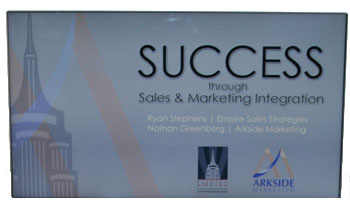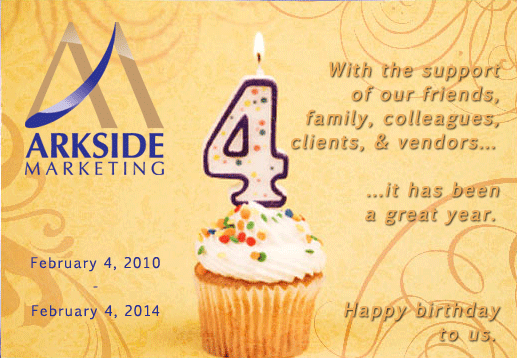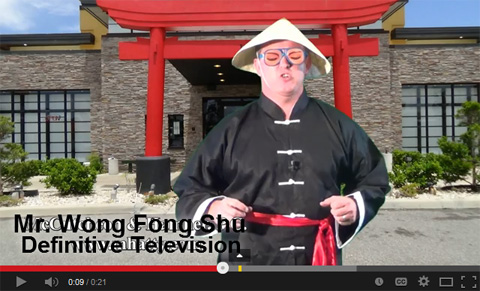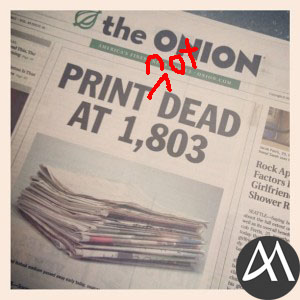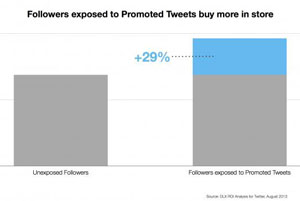SUCCESS through Sales and Marketing Integration Recap
WORKSHOP:
SUCCESS through Sales and Marketing Integration
DATE:
January 23, 2014
HOSTS:
Arkside Marketing
Empire Sales Strategies
SPEAKERS:
Nathan Greenberg, CEO of Arkside Marketing
Ryan Stephens, CEO of Empire Sales Strategies
LOCATION:
Canyon Crest Country Club
Riverside, CA
ATTENDANCE BENEFITS: Complimentary lunch
Nearly $1,000 in raffled business products and services
 We were proud to co-host a great workshop titled, “SUCCESS through Sales and Marketing Integration” with our friends at Empire Sales Strategies. It was our first collaboration and the results were not only great for us, but for each of the nearly 50 business owners and managers that attended.
We were proud to co-host a great workshop titled, “SUCCESS through Sales and Marketing Integration” with our friends at Empire Sales Strategies. It was our first collaboration and the results were not only great for us, but for each of the nearly 50 business owners and managers that attended.
The goal was to highlight the benefits of integrated sales and marketing efforts to improve performance in both areas, increase revenue, and decrease wasteful spending.
For example, it was revealed in a national study that businesses which integrate their sales and makreting efforts see an average of 39% year-over-year revenue growth when compared to their non-integrated competition. Our CEO, Nathan Greenberg, and the CEO of Empire Sales Stategies, Ryan Stephens, used that fact as their guiding principle when developing the workshop.
 Throughout the one hour workshop, both presenters illustrated the “why” and “how” to make changes in current business operations to improve performance and decrease waste. Each attendee was given a worksheet with five “take away” items they could apply to their business and begin making changes that afternoon.
Throughout the one hour workshop, both presenters illustrated the “why” and “how” to make changes in current business operations to improve performance and decrease waste. Each attendee was given a worksheet with five “take away” items they could apply to their business and begin making changes that afternoon.
As part of a good marketing program, each attendee was given a feedback form at the end of the event and asked to rate various aspects and the event overall. With comments like these, you can bet another workshop will be hosted in the second quarter of the year!
We would like to thank the following companies for donating a raffle prize to the event:
- Tax And Bookkeeping Solutions
- Carefree Romantic Vacations
- Canyon Crest Country Club
- eTop Technology
- Inland Empire 66ers
- Ashley Lyons Floral Artistry
- Paychex


Celebrating 4 Years of Doing Marketing Better
by Nathan Greenberg, CEO
We begin our celebration with words of thanks.
Those that have invested in our company have given us the financial security to make necessary decisions.
Those that have trusted us with their marketing have given us the relationships we value and seek to build in a unique and dynamic way.
Those who have referred their friends, family, and associates to us have given us the trust and support to grow.
Those in the media who have partnered with us and delivered amazing results to our clients have given us the tools to make marketing and advertising exciting and profitable.
Those friends and family who have supported our decisions, helped us avoid pitfalls, and let us toil away at odd hours and miss other moments.
To all of you I give a personal “thank you”.
Four years is only our beginning. This year, in particular, has been so radically and positively different from the first three. I humbly admit that every decision has not been right. Nevertheless, I remain committed to my foundation of giving the best customer service and building relationships with clients, the media, and our fans who have helped us grow.
I have more exciting plans for this year including new services for our clients, new opportunities for our clients and partners to network with each other, and bringing on new talent to further expand our well of services and abilities.
The years ahead are bright and I look forward to sharing them with all of you.
–Nathan Greenberg, CEO
Arkside Marketing, Inc.
Law Firm Badly Disavows Racist Commercial
Cardinal sin of advertising: racism.
Divine blessing of advertising: a good ad agency.
The law firm of McCutcheon & Hammer seems to be the unfortunate victims of advertising that they didn’t want. According to them, they didn’t even pay for it. Or ask for it. A commercial production company created the offensive ad below using a horrible Asian stereotype character and it was uploaded to the firm’s YouTube channel. Check it out below (on the production company’s YouTube channel) and then scroll down for updates since the video was discovered last week.
Things got weird once the video went viral. The law firm claimed that it never commissioned the video and that their YouTube channel was hacked. It is a fair assumption that a local TV production company doesn’t have the ability to “hack” YouTube (which is owned and secured by Google). So let’s assume the law firm is using some legalese and hinging the accuracy of their statement on the first part of the statement. They never commissioned this particular video and, therefore, never authorized it being uploaded to YouTube.
Since both sides make opposing claims and the ad involves a very derogatory portrayal of Asians, the Natiaonl Asian Pacific American Bar Association has looked into the situation and made some odd discoveries:
1) Neither party is willing to produce documentation to support their claim.
2) Neither party is eliminating the idea that someone pretending to work for the law firm is responsible. (If this is true, the production company is disastrously negligent in their client authorization process!)
3) The video is still online.
4) The law firm has not followed through with any threat to sue the production company.
5) This is still very bad PR for the law firm and production company.
All that said, the judgment on this one is bad all the way around. The production company makes junk, and racist junk at that. The law firm has done terrible damage control. If this were professionally handled at the onset, it would have been cleanly wrapped up and the reputation of the firm would still be in tact. Such is not the case today.
Decline in Facebook Page Organic Reach
It isn’t a rumor, nor is it a conspiracy. Facebook organic reach has been slashed. Facebook has admitted to changing its algorithm so businesses (or anyone else with a Page) are forced to pay if they want their posts to be seen. While most businesses saw a decline to about 15-20% organic reach last year, many are now reaching only 2%. In the case of the Arkside Marketing Facebook Page, we are seeing 5-8% consistently.
Facebook has become the bridge troll with a pay-to-play model.
General Motors Called Facebook’s Bluff
The origin of this change reaches back about a year and a half. Facebook had one billion users and was the place to be. Many Fortune 500 companies were clamoring to get on the bandwagon but still hadn’t figured out how. Even at the end of 2012, only 66% of the F500 were on Facebook, let alone using it effectively.
But in May 2012, General Motors’ firebrand CMO, Joel Ewanick, made the decision to fire their social media agency of record and stop all advertising on Facebook. Quick way to save $10 million. The stated reasoning was that they didn’t see any substantial return on their investment so they would stop advertising and continue with their organic Facebook Page fan base of a few million followers.
Even with Facebook making it impossible for brands to reach 100% of their followers, most were still seeing what you posted. Why advertise? Faceb0ok was cannibalizing itself. Why buy the cow when you can get the milk for free?
Not only did they just eliminate themselves as a top Facebook advertiser (and revenue source), but they did this the week Facebook had their IPO. Ouch.
We believe Joel was right.
Ewanick and General Motors exposed the flaw in Facebook’s plan. Spending wasn’t necessary because people were organically finding, Liking, and sharing brand content.
Facebook had to fix the giant hole in the ship. Now you have to pay to get on board.
Effect on the Facebook Page for Business
Post-IPO, Facebook has been under immense public pressure (especially from our own Founder who has had issues with the platform). They have been busy addressing their failure on mobile devices and an unfriendly ad platform. Organic results were odd also. For many years, it has been frustrating for businesses on Facebook because they are treated badly. Even when a customer says they “Like” a business, Facebook doesn’t see that as permission to show your content. In their belief, just because a customer says they “Like” something, that doesn’t really mean they want to see anything from it.
In high school, guys wanted “no” to mean “yes”.
On Facebook, “yes” actually means “no”.
Now, “yes” actually means “no way in hell”. So what is a business to do? According to Facebook, a business is to pay for ads.
“Your brand can fully benefit from having fans when most of your ads show social context, which increases advertising effectiveness and efficiency“.
Perhaps the most offensive and glaring admission is this:
“We expect organic distribution of an individual page’s posts to gradually decline over time as we continually work to make sure people have a meaningful experience on the site.“
If someone tells you they like something and you block them from seeing it, how does that equal a meaningful experience?
Social Media Sharing Options
1) Save Money and Reach Fewer People
There are many social media agencies and managers that we have spoken to whom have told us they will be focusing less of their time (and their client’s money) on Facebook Pages. In their view, the task of reaching a fan base is so time consuming and expensive that better results can be found on other social media or even traditional media.
2) Spend Money and Reach More People
Other social media agencies and managers have said they will pay, if necessary. Facebook wants to command paid media and may be a force that is too large to ignore. For those companies with substantial followings in the thousands or hundreds of thousands, a marketing investment may be a wise decision.
At Arkside Marketing, we have saying, “advertising is an investment. If it is only an expense, you are doing it wrong.”
3) Leave Facebook
Yes, we’re serious. For some businesses, the Facebook Page organic reach may have provided a nice bump in social interaction, but their new model decreases the return that could possibly be achieved. Could that time be better spent on other social platforms such as Twitter or the SEO-friendly Google+?
In the spirit of full disclosure, we have not recommended that any of our clients abandon Facebook. Each of them can continue to successfully reach their audience, but to a smaller degree. We also plan to continue our own Facebook presence, but will reduce our advertising to large announcements.
Facebook In The Future
Although we agree with his decision, we blame Joel Ewanick for this. Ultimately, it would have occurred anyway. Facebook had to realize their shortcoming. But now that it is here, what will your business choose? The pay-to-play model is here to stay, mainly because it doesn’t seriously infringe on Facebook’s main product: its users.
Contact Us
If you would like an objective evaluation of your social media presence and strategy, contact our office.
News Release: Cyndi Lemke Joins Arkside Team
FOR IMMEDIATE RELEASE
December 16, 2013
From: Arkside Marketing
Media Contact: 951.444.1237
info@arksidemarketing.com
###
AD AGENCY BRINGS ON NEW MARKETING TALENT
Growing Southern California ad agency brings on specialized talent for highly regulated industries.
(Moreno Valley, CA) Arkside Marketing has retained the services of Cyndi Lemke, formerly of Soboba Casino, Target, and Kenneth Cole, to further strengthen their efforts and expertise in highly regulated industries such as law, casinos, automotive, healthcare, and education. Ms. Lemke brings a wealth of experience from her previous positions with large and small business entities.
 “At Ms. Lemke’s first contact with us, I was excited at the opportunity to bring her on board,” said Nathan Greenberg, Founder of Arkside Marketing. “Our clients expect a high level of knowledge gained through experience in complex marketing strategies. Ms. Lemke’s background makes our team much stronger in that regard.”
“At Ms. Lemke’s first contact with us, I was excited at the opportunity to bring her on board,” said Nathan Greenberg, Founder of Arkside Marketing. “Our clients expect a high level of knowledge gained through experience in complex marketing strategies. Ms. Lemke’s background makes our team much stronger in that regard.”
She has spent the last 18 years working in retail management and marketing. Her professional passion of helping others succeed aligns well with the mission of Arkside Marketing: to solve their clients’ business challenges. Ms. Lemke said joining a company like Arkside will, “give me opportunities and a professional atmosphere not commonly found in this industry. I’m looking forward to this journey.”
Arkside Marketing is a full service advertising and marketing agency serving industries with high levels of government oversight. Arkside’s foundation is built on the harmony between traditional and digital mediums while providing the highest levels of customer service. Offered services include traditional media buying, campaign strategy, brand development, digital ad campaigns, graphic design, website development, social media, reputation monitoring, and market research.
#END#
Is Print Media Dead?
Yes.
and
No.
The question “is print media dead” is much harder to answer than you expect. The reasons are complex and the answer is changing. Today, it would depend on what part of “print” you’re asking about. Print marketing includes newspapers, direct mail, magazines, coupon publications, and others. If any of them are “dying”, it does not mean mean they have lost utility or effectiveness.
Newspaper Advertising
The century-plus old technology has faced small year-over-year declines, but overall, has fallen for a decade. This is only true of their print editions. Most newspapers in America have made transitions to digital editions to various degrees. Their digital efforts have seen robust growth in most cases. Because of this adaptation of new media, the budgeting and targeting of an ad campaign is vital for positive ROI in newspapers.
Your Marketing Consultant should know the publication and work closely with the media representative to ensure a customized campaign for you. Very little in advertising is one-size-fits-all. The demographics should be understood and costs thoroughly explained so that expectations can be appropriately set.
As will be mentioned in each print advertising category below, the benefit of a media mix should not be ignored when considering “dying” print. How can newspaper work in tandem with radio or television? How can online ads on the high school sports webpage help support your community relations or targeting of active families? Work with your Marketing Consultant to explore these opportunities.
Direct Mail Advertising
Your customers want to build relationships and so do you. Direct mail is routinely rated one of the least intrusive forms of advertising. According to a recent study on direct mail by Millward Brown, “physical media left a ‘deeper footprint’ in the brain”. In other words, people remember more about something they can touch as opposed to something they can not.
But what about results? Doesn’t everyone throw out “junk mail”?
Target Marketing magazine conducted a study on ROI and the media producing the best results for customer acquisition, customer contact, and retention for B2C marketers was direct mail. It is easy to track and that makes it easy to understand and source it’s performance.
Magazine Advertising
Beautiful, glossy pages filled with beautiful people and products. Although not as hard hit as newspapers, magazines have seen challenges erupt over the last decade. But there are many success stories and evidence of a rebound in the industry. Just last week, Newsweek announced it would restart its printed publication. Publications are seeing a growth in readership and revenues are on the rise.
As long as magazines are used effectively and for the right goals, they can be a powerful element in your media mix. Some data suggests that you only get half a second to make an impression before someone decides if they will read your magazine ad or not.
Focus on what you want people to notice. This could be a call to action, a logo, or a photo. If appropriate, include contact information and a reason for people to use it. Like all ads, your space is limited so use it wisely and beautifully.
Coupon Advertising
We may be climbing out of the recession, but people still love a discount! Find the publication or mail package that is most likely to reach your target market. Just because you publish a coupon doesn’t mean it will get used. Targeting is critical and must be combined with a worthy offer.
Again, time and space are limited. You have less than a second to make an impression and only so many inches to use. Keep your disclaimers short, your dollars or percentages big, and your contrast strong.
There are many options such as Welcome Wagon, which targets new home owners, or PennySaver which stretches “from sea to shining sea”.
How To Advertise in Print Media
Is print media dead? No. It is changing and rebuilding but it remains extremely successful for advertisers. Contact an Arkside Marketing Consultant today and explore your best options.
Facebook Star Rating System Mystery
By now, it is no surprise that Facebook has launched another feature without much explanation of how it works. They do this with EdgeRank updates and advertising options. Of course, privacy glitches features have been repeatedly changed without explanation as well.
Almost Nothing Added to Facebook Help
In this case, Facebook unveiled a new 5-star rating system for business Pages and at least two weeks have gone by since any details have emerged from the Menlo Park headquartered company. The star ratings appear under a business name on their Page and seem to be visible to all Facebook users.
This is what we know from the two questions Facebook has added to its help section:
- For a business to be rated, it must add an address to its profile
- Businesses can remove their ratings by removing their address from their profile
- Comments can accompany ratings, but they are not required
Unanswered Star Rating Questions
Other than showing the rating to the public, Facebook has not shared what this means to the Page owner.
1) Does a score impact how a Page appears in search results?
2) Why not show how many ratings have been received?
3) Are mobile and desktop ratings scored equally?
4) Are any filters applied to “score” ratings? (i.e. – John Smith has 1,000 friends and reviews many businesses…will his rating be worth more than Jane Doe who has 100 friends and rates 1 business a year?)
5) How are false reviews flagged/responded to/deleted?
As we said, these important issues are not being addressed so the system is of little value to businesses today.
Another Voice for Customer Service
However, there are some noteworthy elements about the project in general. The Facebook star rating seems designed to infringe on the business models of companies like Yelp and FourSquare. By connecting a rating system to a business’ Facebook Page, it reduces the need of someone to leave and see how they rank on another site. It also mimics the Page/Places/Local integration currently being attempted by Google on their Google+ social media platform.
It is the integration that is key. Social media sites are continuing to explore new options to integrate themselves into a user’s daily life. It also puts another focus on customer service within a business and making that reportable to the public. More and more, businesses are being forced to provide better experiences because each customer has a voice.
Facebook alone has 1.1 billion voices.
The new rating system is yet another element that must be incorporated into a business’ reputation management and overall social media efforts. They must solicit reviews from current customers, monitor their star rating, and promote a four or five star score.
5 Tips for a Successful Business Card
Business cards are still an effective and convenient method for distributing your contact information. Ignore the small chorus of nay-sayers who ponder the question, “is the business card dead?” A business card is a valuable and inexpensive investment. Here are 5 tips to make your business card effective:
- Order Business Cards from Arkside
Its a good idea, but that’s not really number one. Here we go…
1. Make Your Business Card Easy to Read
Simple form over function. It doesn’t matter how beautiful your business card is if no one can read it. Even if you are an artist or graphic designer. Don’t let a creative flair overtake the reason you have a business card…so people can contact you! There are plenty of ways to incorporate beautiful, colorful, extravagant designs and still have easy-to-read information.
2. Use Both Sides of Your Business Card
2″ high by 3.5″ wide.
Two sides.
That gives you 14 square inches of space to work with. Don’t let it go to waste. When clients come to us for brand development, we often find a misuse of space in their business cards, letterhead, envelopes, and websites. Your business card can communicate a lot of information including:
| Logo | Name | Title |
| Company | Address | Phone |
| Fax | Social media | |
| Company Slogan | Specialties | Awards |
| Images | Certifications | Degrees |
| License number(s) | Special prices | Discount offers |
| Famous quote | Appointment form | Portfolio piece |
With all of those possibilities, why would you leave the back of your card blank? Put it to good use. Don’t just copy your logo again in a larger size. Use it as an appointment reminder (many dentists and doctors do this). You could also promote a particular product line, include social media icons/addresses, share your industry recognition award, or give a useful tip that is relevant to your customers.
3. Design Business Cards With Your Customer In Mind
Your business card needs to meet and exceed the expectations of the person to whom you give it. If you own a law firm catering to high net worth clients, your business card needs to reflect that. The design should be professional and elegant. Including the colors of your favorite baseball team is not recommended.
Utilize your color palette, fonts, and other brand design elements. This information should be readily available in your branding guidelines.
4. Print Your Business Card on the Right Material
Many years ago, we came across a company that had plastic business cards. They had a custom cut shape, full color, and nearly as thick as a credit card. EACH card was about $1.00. Yes, they spent $500 on every set for employees. They were beautiful, unique, and effective.
They were not cost efficient.
The same unique beauty could have been achieved on a paper stock, even a rarely available stock, for less than $1.00 per card. Use a stock that is appropriate for your customers. A heavy-duty card stock for rough industries such as construction or landscaping. Elegant linen is appropriate for accountants or attorneys. Plastic for…well…no one.
5. Steal Ideas for Your Business Card
The layout and content options for your business card are limitless. But you aren’t going to reinvent the wheel. Someone already did what you want. Best of all, someone already did a part of what you want.
“Good artists copy, great artists steal!” –Pablo Picasso
Start collecting business cards with things you like and want on your own: a great font, a nice placement of a logo, the right size social media icons, whatever.
Now use this opportunity for marketing and networking. Compliment the person who’s card you admire and tell them what you like. They’ll appreciate your kind words and will be more receptive to your card once it is ready.
FREE TIP
6. Order your business cards from Arkside. (Just contact our office and we’ll schedule a free consultation.)
If you could change one thing about your current business card, what would it be? Leave a comment below and let’s see what others want to improve.
Twitter Study: Online Tweets Drive Offline Sales
In case you haven’t heard, Twitter plans to go public with an IPO sometime in 2014. Cheekily, they made this announcement in a tweet. Now they are under intense pressure to prove their value. How can Twitter be profitable? Can it grow? Can it help business? How will it attract advertisers? With a recent blog post, Twitter has set out to prove that tweets drive offline sales.
Majority of Sales are Still Offline
Twitter partnered with Datalogix to determine the impact Promoted Tweets (and tweeting in general) had on offline sales. Despite the surging popularity of social media with businesses and their consumers, 94% of purchases in America are still made offline, according to the U.S. Census Bureau.
So how can businesses use Twitter to impact their offline sales?
Promoted Tweets, according to Twitter.
How Twitter Impacts Offline Sales
The logic is fairly simple but execution is key. Tweeting is about condensing any idea or action into a message of 140 characters or less. The people that see those messages have just become a branding audience and, in most cases, the goal is to move from branding to action. You want people to act on the information or call-to-action you provide.
When 35 CPG brands were studied, it was determined that Promoted Tweets (one of Twitter’s advertising products) directly correlated to a 12% sales lift offline. Also impressive, organic Tweets helped push an 8% offline sales lift.
Impressed? Wait, there’s more. (We’re not cheerleaders for Twitter. This just happens to be excellent marketing data that we believe can help our clients achieve great success in social media and gaining incremental sales. You want to sell more, right?)
Twitter’s data also showed that customers exposed to Promoted Tweets bought 29% more than customers who were only exposed to organic Tweets.
Measuring Social Media Impact
Twitter has helped advance the measurement metrics of online promotion affecting offline sales. It is a critical tool for any brand who seeks to grow their business with the inclusion of social media in their marketing mix. Verifiable sales are an element of measurement, just like website traffic, online buzz, or media coverage.
Facebook also had a recent announcement about conversion from online ads to offline purchases. This segment continues to grow and should not be ignored.
Summary
It is becoming more difficult for skeptics to deny the importance of social media in marketing. Its importance has been documented for SEO objectives and its genuine dollars-and-cents value is being better quantified every day. If you would like to learn more about effective social media and how it can lift your sales, please contact Arkside today.
News Release: Richard Aguayo Joins Arkside Team
FOR IMMEDIATE RELEASE
Ad Agency Brings on New Sales Talent
Full service ad agency in Southern California expands and deepens experience base with multifaceted sales and management veteran.
Moreno Valley, CA (September 20, 2013) – Arkside Marketing has retained the services of Richard Aguayo to contribute a new dimension to their sales and consultation efforts. Mr. Aguayo has demonstrated an accomplished sales career over the last six years as well as managing a variety of businesses for many years before that.
“Richard was referred to me as someone with a positive attitude and deep desire to help others succeed,” said Nathan Greenberg, Founder of Arkside Marketing. “Whether it is for our clients or the other members of the Arkside team, that is the kind of attitude that I’m looking for.”
 He has spent the last four years working in digital and print media, specializing in multi-media integration. He has an exceptional record of great customer service and is committed to solving clients’ marketing challenges. On his own goals and accomplishments, Mr. Aguayo had this to say, “I have a passion for assisting small to large business reach their goals through a consultant approach.”
He has spent the last four years working in digital and print media, specializing in multi-media integration. He has an exceptional record of great customer service and is committed to solving clients’ marketing challenges. On his own goals and accomplishments, Mr. Aguayo had this to say, “I have a passion for assisting small to large business reach their goals through a consultant approach.”
Arkside Marketing is a full service advertising and marketing agency serving a variety of industries since 2010. Arkside’s foundation is built on the harmony between traditional and digital mediums while providing the highest levels of customer service. Offered services include media buying, campaign strategy, brand development, digital ad campaigns, graphic design, website development, social media and reputation monitoring, and market research.

